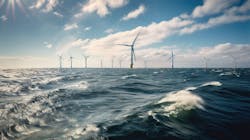Opinion: Offshore wind developers face fragile climate timeline
By Jessica Merkel, Energy Shares LLC
Wind is one of the fastest growing types of renewable energy in the US, partly because project developers are able to tap into the natural resource both onshore and offshore. However, each comes with its own individual challenges as well as some shared challenges. An omnipresent obstacle across all renewable energy projects is time, and wind projects are no exception.
As the world scrambles to electrify and decarbonize the electricity sector all at once, renewable energy project developers are facing the shrinking timeline of meeting net-zero goals in time to avoid the increasingly catastrophic effects of climate change. On top of the added pressure of a looming climate crisis, there are additional bottlenecks in the development process, particularly for offshore wind farms.
Onshore versus offshore
Some of the common challenges in offshore wind include a lacking workforce, difficult engineering and regulatory requirements (as compared to onshore wind), supply chain interruptions, additional transmission to carefully move power from offshore to onshore, and long interconnection queues. Not only do these bottlenecks slow down the development process for an already lengthy project timeline (averaging about nine years for an offshore wind project to become operational), but they also suggest that the projects need to receive significantly more funding to continue other development activities.
Onshore wind is no stranger to many of the same bottlenecks, however, the average timeline is much shorter to become fully operational, in part due to the lesser sizes and capacities. Onshore wind has a shorter development timeline and needs less upfront financial support; however, there are also difficulties getting through the US’ backed up interconnection queue and workforce challenges. Still, an onshore wind project takes much less time to develop, construct and become fully operational as compared to its offshore counterpart.
Developers must balance the aspects of a fragile climate crisis timeline and rapidly growing electricity demand (and need) with the widespread electricity decarbonization effort. If time is the most pressing issue, then perhaps it is encouraged to pursue projects that require less time, such as an onshore wind project, notably one of the most time-efficient clean energy projects to develop, on average.
However, there are other aspects to consider such as energy efficiency, reliability and overall output, in which offshore wind would likely be a more viable option in the long term, as it is celebrated for having higher reliability and consistency than onshore wind. If pursuing offshore wind farms, developers are encouraged to act now before it is too late in the energy transition to allot for the time it takes for an offshore wind farm to become interconnected and fully operational for consumer use. In short, the window for these types of projects is closing hastily.
Funding difficulties
With any renewable energy project, financing is a common obstacle as well, with finances typically coming from managed funds, institutional investors, etc. Due to the sheer size and compulsory additional equipment needed for an offshore wind project, a massive amount of funding may be needed and could be more difficult to acquire in a timely manner than an onshore wind project. While there may be more current opportunities for offshore wind, as the popularity of onshore grows rapidly in the US, onshore wind may be a more realistic path for developers to complete projects at the acceleration needed to meet climate goals. With a rise in alternative methods of funding to assist in quicker deployment of clean energy projects, such as crowdfunding models, both types of wind projects may be able to advance simultaneously without pushing back timelines due to financial constraints.
It is up to developers to holistically consider what is worth prioritizing against a closing timeline. Offshore wind may have a more difficult and lengthy development process than onshore wind, but it has its own benefits in the long term that developers may favor and feel are worth prioritizing now, despite the current industry barriers.
Energy Shares LLC is a FINRA registered broker-dealer and equity crowdfunding platform for utility scale renewable energy projects in the US. Energy Shares expands access to renewable energy investment opportunities previously only available to institutional, corporate and a limited number of retail investors. The Energy Shares platform is a centralized place where investors and project developers can connect to fund projects and accelerate the adoption of renewable energy in the US.
